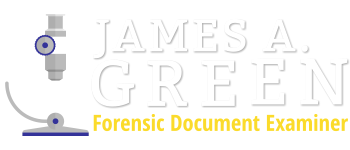When investigating questioned documents, even the smallest details can provide significant insights. One often overlooked aspect is indented writing, a subtle yet critical element that can help uncover the truth in legal, financial, and personal disputes. Indented writing refers to the non-visible impressions left on a sheet of paper positioned beneath the page being written upon. These impressions, while not immediately apparent, can hold vital information in cases involving journals, medical records, accounting logs, contracts, and more.
What is Indented Writing?
Indented writing is created when pressure from a writing instrument transfers onto the underlying pages. This occurs naturally during the act of writing, leaving faint impressions that may capture portions of handwriting, numbers, or even entire entries from the page above. While these impressions are invisible to the naked eye, they remain embedded in the fibers of the paper and can be recovered using specialized techniques.
In many cases, indented writing can:
- Reconstruct lost or missing information: Recover content that was written on a removed or destroyed page.
- Confirm document sequence: Verify the continuity of entries in journals, logs, or medical records.
- Expose tampering or fraud: Identify inconsistencies, such as skipped entries, alterations, or added pages.
Recovering Impressions
Traditional methods of recovering indented writing—such as rubbing a crayon or pencil over the paper—are destructive, damaging the document and altering its evidentiary value. Forensic document examiners use advanced, non-destructive methods to recover this valuable information without leaving any marks or damaging the document.
One of the most common tools used is the Electrostatic Detection Apparatus (ESDA), a highly sensitive device designed to recover impressions. The ESDA works by applying an electrostatic charge to the document, allowing a fine powder to adhere to the indentations. This process produces a clear, tangible image of the indentations, preserving the original document’s integrity.
Case Applications
The ability to recover indented writing has proven invaluable in many types of cases:
- Medical Records: A patient’s chart may contain impressions from prior entries, providing a timeline of care or revealing missing or altered records.
- Financial Documents: Accounting logs or checks with indentations can confirm fraudulent alterations or establish the sequence of transactions.
- Journals and Diaries: Indented writing can uncover hidden entries or verify the authenticity of recorded events in personal journals.
- Legal Contracts: Impressions from signatures or handwritten notes may reveal tampering or discrepancies in key documents.
Why a Qualified Document Examiner is Essential
Recovering and analyzing indented writing requires both specialized equipment and expertise. A qualified forensic document examiner is trained to use tools like the ESDA, as well as other non-destructive methods, to reveal hidden evidence without compromising the original document. Beyond recovery, these professionals interpret the recovered information, identifying patterns, inconsistencies, or tampering that may not be immediately apparent.
Additionally, document examiners often provide expert testimony in court, explaining their findings in a clear and objective manner. Their analysis can significantly impact the outcome of cases involving fraud, disputes, or missing information.
The Importance of Indented Writing in Uncovering the Truth
Indented writing is a powerful tool in the field of forensic document examination, offering insights that are often invisible to the untrained eye. Whether reconstructing missing information, confirming document integrity, or exposing fraud, the recovery of messages provides critical evidence in high-stakes cases.
If you suspect that indented writing could help resolve your document issue, consulting a qualified document examiner is an essential step. Their expertise ensures that this valuable evidence is recovered, preserved, and analyzed with the highest level of precision.

